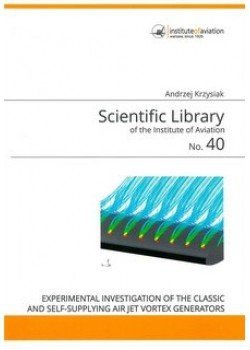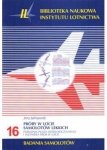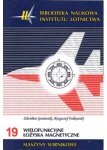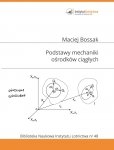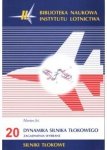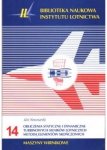-
Załączniki bezpieczeństwa
Załczniki do produktuZałączniki dotyczące bezpieczeństwa produktu zawierają informacje o opakowaniu produktu i mogą dostarczać kluczowych informacji dotyczących bezpieczeństwa konkretnego produktu
-
Informacje o producencie
Informacje o producencieInformacje dotyczące produktu obejmują adres i powiązane dane producenta produktu.Instytut Lotnictwa
-
Osoba odpowiedzialna w UE
Osoba odpowiedzialna w UEPodmiot gospodarczy z siedzibą w UE zapewniający zgodność produktu z wymaganymi przepisami.
The work is a summary of many years of experimental research conducted by the author of this monograph in the area of flow control and refers to the usage of air jet vortex generators. Flow control may be applied in many technical fields. The book is focused on the usage of flow control techniques in aeronautics within the range of subsonic velocities.
In the first few chapters an overview of the “state-of-the-art” of the flow control techniques, including, in particular, vortex generators is presented. This review has been made on the basis of the proposed division of the presently used flow control techniques, which has taken into account the dominant nature of the flow, i.e. laminar or turbulent. The achievements in the area of flow control using air jet vortex generators were discussed most extensively.
The original author’s contribution to the science, in the area of flow control techniques, are presented here so-called self-supplying air jet vortex generators. For producing vortices this technique uses airfoil overpressure regions as a source of the air (for them). As a consequence, this solution is much simpler to implement, in comparison, with the hitherto used classic ones, which uses a compressor, as a source of the air for generators. Furthermore, the experimental investigation showed that effectiveness of proposed self-supplying air jet vortex generators is comparable with classic air jet vortex generators.
In subsequent chapters, results of experimental studies of the basic aerodynamic characteristics of NACA 0012 airfoil model segments, equipped with both classic air jet vortex generators (supplied with air from a compressor) and proposed, self-supplying air jet vortex generators (supplied with air from the overpressure areas) are presented. The research was carried out in two wind tunnels of the Institute of Aviation. As part of those works, research has been done concerning the influence of selected design parameters of the classic air jet vortex generators on the airfoil aerodynamic characteristics and the optimization of those parameters (due to the effectiveness of the generators, estimated on the base of CLmax and acr increases).
Next, an experimental verification of the effectiveness of the proposed self-supplying air jet vortex generators was performed by comparing their effectiveness with the classic ones. The visualization of vortices formed over the upper surface of the airfoil using both types of generators was a supplement to the experimental verification.
The penultimate chapter of this book presents the concept of increasing the effectiveness of the proposed self-supplying air jet vortex generators by creating dual coupled vortices.
In the last chapter, the results of experimental tests of the application of self-supplying air vortex generators to control the dynamic stall on retreating helicopter rotor blade are presented.
Nazwa publikacji: EXPERIMENTAL INVESTIGATION OF CLASSIC AND SELF-SUPPLYING AIR JET VORTEX GENERATORS
Autor: Andrzej Krzysiak
ISBN/ISSN: 978-83-63539-25-2
Oprawa: miękka
Data publikacji: 2016
Wydawnictwo: Wydawnictwa Naukowe Instytutu Lotnictwa
Liczba stron: 112
Wydanie: angielski




